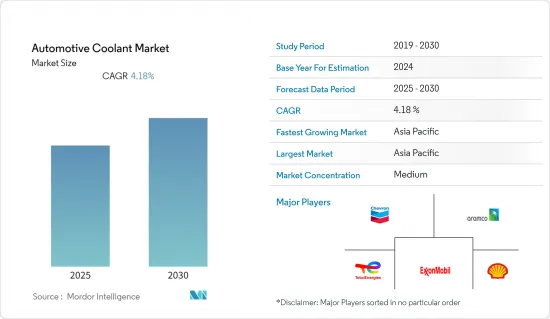PUBLISHER: Mordor Intelligence | PRODUCT CODE: 1686638

PUBLISHER: Mordor Intelligence | PRODUCT CODE: 1686638
Automotive Coolant - Market Share Analysis, Industry Trends & Statistics, Growth Forecasts (2025 - 2030)
The Automotive Coolant Market is expected to register a CAGR of 4.18% during the forecast period.

The COVID-19 pandemic had a substantial impact on the global economic landscape. Concerns about potential business closures and recession hit the automotive coolant market. Moreover, registrations of new vehicles have been on a decline as lockdown orders have restricted the number of vehicles running on roads. However, the automotive industry is now recovering from the losses and paving the way to introduce quality products to cater to the rising demand from consumers across the globe. The automotive industry witnessed significant growth in terms of production in 2022, and is further anticipated to grow during the forecast period. With th increasing vehicles on road, the demand for coolant is antiicpated to increase signfiicantly during the forecats period.
Over the medium term, The market's expansion is being fueled by the automotive sector growing throughout the world. In recent years, there has been an increase in demand for passenger vehicles, which has aided market expansion. Furthermore, end user acceptance of reusable coolant types has been boosted by strict regulatory requirements for the safe disposal of antifreeze material and its recycling.
Key automakers are still offering diesel and gasoline vehicles which have fueled up the engine coolant demand across the globe. Key coolant manufacturers are providing resistance-free chemicals inside the coolant which avoid the corrosion of engine components. In addition, coolant has also played the most crucial role in upbringing the vehicle mileage thus, anticipating a high adoption rate over the study period.
The rise in demand for vehicles and automakers and continuous investments in R&D for the development of cost-effective, environment-friendly, and less toxic products with a high life are likely to boost the automotive coolant market during the forecast period. Moreover, the easy and abundant availability of various materials, including ethylene glycol, propylene glycol, and glycerin, in developed countries helps new entrants develop such products and also drives the automotive coolant market.
Automotive Coolant Market Trends
Passenger Car Segment Likely to Dominate the Market
The passenger car segment is likely to hold a significant share of the market by the end of the forecast period owing to a rise in the demand for utility vehicles in highly populated countries such as China, India, and Brazil.
Automobile manufacturers are introducing newer brands and products to offer customized coolant and lubricant solutions for customers, expanding the automotive coolant market's share. Several global OEMs are investing in the country through either joint ventures with established players or after FDI norms have been invested directly in setting up their production units or enhancing their sales and dealership networks across the country. For instance,
- In December 2021, ExxonMobil announced that it had finalized corporate plans, which include increasing its spending to USD 15 billion on greenhouse gas emission-reduction projects over the next six years while maintaining disciplined capital investments in its industry-leading portfolio.
- In May 2021, Chevron Corporation and Noble Midstream Partners LP announced that they had completed the previously announced acquisition, which resulted in Noble Midstream becoming an indirect, wholly-owned subsidiary of Chevron.
Moreover, high demand for e-class, crossovers, SUVs, and hatchbacks is driving the passenger vehicle segment, which, in turn, is likely to boost the automotive coolant market. The rise in preferences for private transport and purchasing power of consumers is driving the passenger vehicle segment of the market.
Asia-Pacific dominating the Market
Automotive Coolant Industry Overview
Additional Benefits:
TABLE OF CONTENTS
1 INTRODUCTION
- 1.1 Study Assumptions
- 1.2 Scope of the Study
2 RESEARCH METHODOLOGY
3 EXECUTIVE SUMMARY
4 MARKET DYNAMICS
- 4.1 Market Drivers
- 4.2 Market Restraints
- 4.3 Industry Attractiveness - Porter's Five Forces Analysis
- 4.3.1 Bargaining Power of Suppliers
5 MARKET SEGMENTATION (Market Size in Value - USD)
6 COMPETITIVE LANDSCAPE
7 MARKET OPPORTUNITIES AND FUTURE TRENDS
8 IN-USE VEHICLE DATA, BY GEOGRAPHY, 2018-2028




